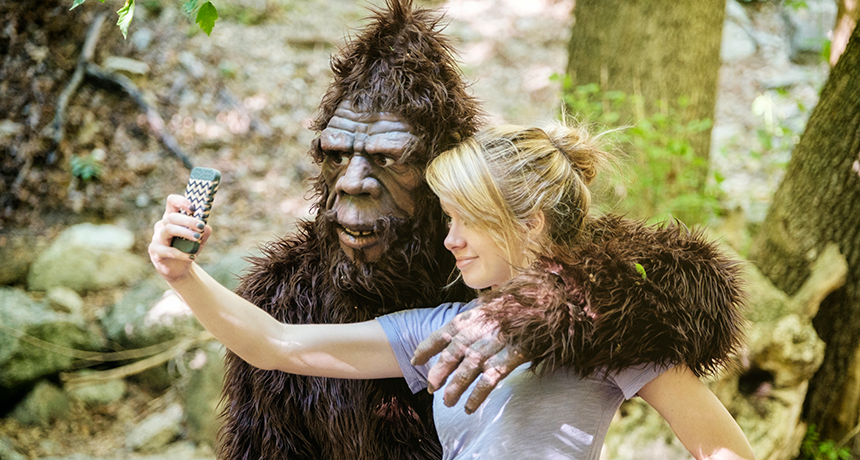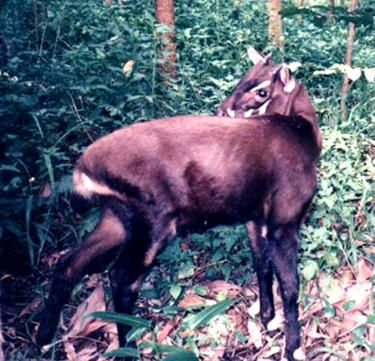Have we found bigfoot? Not yeti
People want to believe in yetis, but the evidence says they’re just seeing bears

Will you ever be able to take a true photo with bigfoot? Sorry, no.
RichLegg/iStock/Getty Images Plus
Yeti. Bigfoot. Sasquatch. The abominable snowman. Lots of people through history have claimed that hiding somewhere in one of the world’s remote forests is a big, hairy “missing link” between people and apes. In the new movie “Missing Link,” an adventurer even finds one. (He’s sincere, funny, driven and named Susan). But while many people have claimed that they’ve collected yeti hair, footprints or even poop — again and again science has burst their optimistic bubbles. Yet these searches for bigfoot are not totally fruitless. The sasquatch search might help scientists find out new things about other species.
Yetis come from myths told by people who live in the Himalayas, a mountain range in Asia. Bigfoot and sasquatch are North American versions of these creatures. But what are they exactly? No one really knows. “It’s a bit weird to think of [a] ‘strict definition’ for yetis, since there isn’t one really,” says Darren Naish. He’s a writer and paleontologist — someone who studies ancient organisms — at the University of Southampton in England.
LAIKA Studios/YouTube
A yeti, Naish explains, “is supposed to be human-shaped, large and covered in dark hair.” It leaves tracks that look human-like but are bigger. Much bigger, he says — as in around 33-centimeters (or 13-inches) long. Self-proclaimed yeti-sighters often describe these beasts as “standing and walking around in high mountainous places,” Naish notes. In other words, they appear “pretty slow and boring.” Yet others have accused yetis of chasing people or killing livestock.
Some writers have suggested that yetis are actually giant apes, or even “missing links” — the last members of some species that eventually evolved into humans, Naish says. Without a real yeti to study, though, scientists can’t know what a yeti is. But that doesn’t mean they don’t have ideas about what they are.
Bear with us
Several scientists have attempted to study material that supposedly has come from yetis. In one 2014 study, for instance, Bryan Sykes at the University of Oxford in England gathered up 30 samples of “yeti” hair. They had been collected by people or were sitting in museums. Sykes’ team searched the hair samples for RNA from mitochondria, which are the structures inside cells that produce energy. RNA molecules help read information from DNA. They also produce proteins that can be used to find out what species the hair had come from.
Most of the hair came from animals that no one would mistake for a yeti. These included porcupines, cows and raccoons. Other hair samples came from Himalayan brown bears. And two appeared similar to hair from an ancient, extinct polar bear. Could ancient polar bears have mated with brown bears to produce modern yetis? Sykes and his colleagues raised that possibility in the Proceedings of the Royal Society B.
Charlotte Lindqvist wasn’t surprised to see that some “yeti” hairs came from bears. But she doubted the possibility they came from polar bears. Lindqvist is an evolutionary biologist at the State University of New York at Buffalo. “We know there is interbreeding between polar bears and brown bears” up in the Arctic, she says. But as cold and snowy as the Himalayas are, they are thousands of miles from the polar bears’ Arctic home. That’s too far, Lindqvist thought, to make likely any romance between a polar bear and Himalayan brown bear.
A film company asked Lindqvist to study yeti samples. She agreed, but not for the yetis. “I wanted the samples,” she says, “to study the bears.” Little is known about Himalayan bears.
Lindqvist got 24 samples of hair, bones, meat — even poop. All were said to have come from “yetis.” Lindqvist and her colleagues then analyzed the mitochondrial DNA — sets of instructions for how mitochondria function — in each. Of the 24 samples, one came from a dog. All the rest came from Himalayan black or brown bears. The two bear species live on a plateau on either side of the Himalayas. Brown bears live to the northwest; black bears to the southeast. Lindqvist and her colleagues published their findings in 2017, also in the Proceedings of the Royal Society B.
Sas-squashing bigfoot dreams
Lindqvist was thrilled. Up until then, she notes, “we had very little information and genetic data from the Himalayan bears.” Now, she found, “we got complete mitochondrial DNA sequences and could compare that with other populations of brown bears.” These data would show, she reports, that the two populations of bears had been split for hundreds of thousands of years.

The study, however, probably won’t stop people from hunting for — or believing in —yeti. “I’m sure the mystery will continue,” she says. “[The yeti] will survive the most rigorous scientific results.”
And there are plenty of reasons to keep the hunt alive, Naish adds. “Quite a few large animals have remained unknown to science until recently.” In the end, they were only discovered by chance,” he says. “Before their discovery, there was no hint that they might exist. No bones. No fossils. No nothing.”
For example, scientists only found out about the saola — also called the “Asian unicorn” — in 1992. Related to goats and antelopes, this animal lives in Vietnam and Laos. “The fact that animals like this can remain unknown for so long always gives scientists hope that other big, amazing mammals might still be out there, awaiting discovery,” Naish says.
People really do want to believe in yetis, bigfoot and sasquatch, he says. After all, whoever finds one will become instantly famous. But belief is more than that, he notes: “People are fascinated by it because they long for the world to be surprising and full of things that most other people no longer believe in.”







